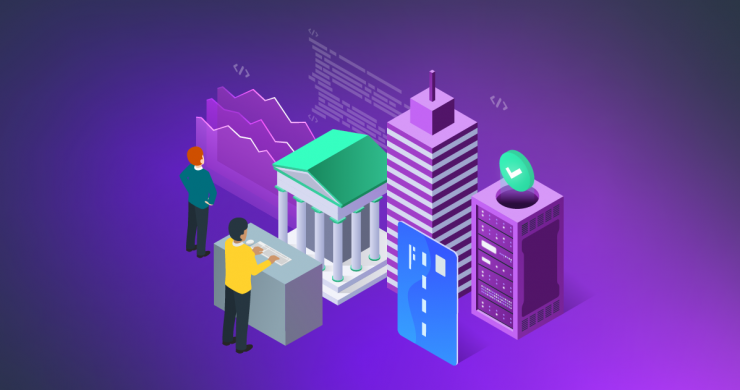5 Ways FinTech Is Transforming Financial Services

The financial industry has a range of challenges and potential threats it needs to stave away to provide an efficient, effective, and secure service to its customers. That’s why they need to utilize the newest and best technologies to keep their service fresh and appealing. Fintech is infiltrating a wide range of areas in the financial services sector and these businesses need to keep up with growing demands. In fact, 64% of financial businesses around the world have adopted Fintech, and a massive 96% of consumers are aware of Fintech services.
But how exactly is Fintech impacting financial services, and how can you implement AI into your financial business? Let’s dive in and find out.
1. Omnichannel Banking
Digital channels are changing the way consumers use their banks and connect with businesses. Long gone are the days of entering a physical bank for financial transactions – omnichannel banking has led to almost everything taking place online.
Omnichannel banking allows customers to seamlessly and consistently make transactions online simply by using a mobile device. It’s making financial services smarter and more convenient for customers to use. It does this by bringing all manners of digital channels together, including social media, mobile devices, and online services.
As an example, we worked with an entrepreneurial bank to create an entire back-end API banking suite. This enabled the backend to attach frontend offerings and create a core banking infrastructure that provides a range of services. The integration of third-party services helped to automate security, smooth the onboarding process, and add a plurality of digital banking features.
As a result of purely digital services, bank branches around the world have seen their physical stores close shop. In 2016, almost 9100 bank branches were closed across the EU alone due to the widespread adoption of digital banking services as part of their Fintech.
2. A.I. enabled process automation
Put simply, A.I. enabled process automation is the automation of processes powered by Artificial Intelligence. There is a huge range of different kinds of A.I. enabled process automation being used across virtually every sector, including the financial sector. Some of these Fintech examples include:
Automated processing
For a lot of processes, many banks still manage them manually, which leads to a tedious and time-consuming task. But automated processes such as payable processing automatically extract, validates, and processes certain data, saving time and resources. Automated processing can also be used in banks to generate financial statements, reconcile account balances, and even help to optimize credit card application processing.
Chatbots
Chatbots have been around for a long time, but they are becoming increasingly popular with online banking services. Chatbots make it easier for banks to streamline and manage customer queries to help save time and resources. It’s estimated that chatbots used in the financial sector could save up to $7.3 billion around the world by 2023.
Chatbots use natural language processing technologies in conjunction with machine learning to learn from human interactions to continue to provide accurate responses. They are increasingly useful for financial services as many chatbots can easily integrate with applications and other technologies for wider usability.
Know Your Customer
Know Your Customer (KYC) optimization is a process of which banking institutes obtain information about the identity and address of their customers to verify their customer’s identities and ensure that their services are not being misused.
KYC is mandatory and all banks must comply with it, and banks spend approximately $500 million on it per year. With RPA being applied here, this process is made much faster and customer data can be analyzed and verified within moments with very little room for inaccuracies.

3. A.I. Banking
A.I. has infiltrated so many sectors and changed the way many businesses operate, including those in the financial sector. Banks are now starting to use A.I. and machine learning to improve their fraud detection efforts, an area that is especially important to invest in, as a record 15.4 million people in the US experienced fraud first hand in 2016 alone.
In the past, banks would need to use a combination of people and software to combat fraudulent activity. The software would detect suspicious activity on an account, and it would then be sent to a human moderator to determine if it was, in fact, a fraudulent transaction. This could be a very time-consuming process, and if an error was made it could cost the bank its reputation.
Implementing A.I. and data aggregation platforms in conjunction with machine learning and process automation can make this process far more efficient. They will be able to use records of successful fraud detection efforts and predict the possibility of a fraud attack before it happens and automatically block it from happening.
4. Security
Biometrics
Over the past few years, we’ve seen the implementation of biometrics Fintech skyrocket. With fingerprint sensors in our cell phones, biometrics is a key feature of our everyday technologies. It’s very difficult to replicate biometric identifiers, and used in conjunction with strong passwords and two-factor authentication, they provide an incredibly secure system that is easy to use.
DAS technology
It’s not just biometric security Fintech that banks can benefit from, but an end to end security from infrastructure to architecture. For example, we worked with a security firm to enhance perimeter security with higher accuracy when it came to a range of different breaches by improving their distributed acoustic sensing technology. Within banking, similar technology can be used to provide extra security for the physical parameters of the building.
Secure communication channels
Financial institutions need to communicate internally and with customers regularly, and often very sensitive information is shared between channels. Keeping these channels safe is essential, so these institutions need to keep up with the latest technological advances.
Banks must use secure communication channels that ensure the security of customer’s financial information, whilst keeping them convenient and easy to use. Email and SMS have been widely used in the past, however, reports show that this isn’t a secure system, as last year in the UK alone, fraud losses totaled £844.8 million. Instead, they need to adopt systems that provide end-to-end encryption, passwords, and two-factor authentication to ensure the safest system possible.
Protection against DDoS attacks
Financial institutions are often the key target of cyber attacks for obvious reasons, and the most common kind of attack is DDoS. DDoS attacks, or Distributed Denial of Service attacks, aim to overload the systems they target by flooding them with traffic from lots of different sources. If banking systems aren’t protected against these, it could expose the sensitive data of their customers and could cost institutions over $2 million US.
One way banks can do this is to harden their networks and expand their bandwidth to ensure they are better off in the event of an attack. Rather than manually monitoring their systems in the event of an attack, financial institutions are increasingly employing a robust DDoS defense system that automatically detects suspicious activities and protects systems against them without wasting time or resources.
5. Blockchain
The blockchain and cryptocurrencies have risen to popularity in the past decade, and it has brought with it new possibilities for Fintech within the financial sector. The blockchain is an open ledger that records and processes transactions, just like a bank does.
The blockchain offers more transparency and security for the exchange of currency, which in turn minimizes the risk of human errors and removes transaction fees completely. With worldwide investment in blockchain solutions expected to reach an estimated 11.7 billion by 2022, we can expect to see it being used increasingly as part of the financial sector in the coming years.
Fintech for the Future of Finance
With the increasing popularity of Fintech being implemented across the board, we can expect huge changes to come within the financial sector. For traditional banks to keep up, they must start to implement these solutions to get ahead of the competition and future-proof their business.
Interested to see how A.I. enabled process automation can impact the financial sector? Our free eBook dives into this as well as the benefits of getting started with A.I. enabled process automation.

Get the latest roundup of the most important, interesting and stories from the past week. In your inbox every Saturday by 10am.
Related Articles you might like
Key Strategies for Financial Institutions to Unlock AI Value
In the financial services sector, artificial intelligence (AI) is often heralded as a transformative force capable of revolutionizing everything from […]
View Blog PostIntelygenz President Chris Brown Shares Vision to Revolutionize Finance in FinTech Magazine
Intelygenz President Chris Brown was recently featured in an in-depth interview with FinTech Magazine, in which he outlined his mission […]
View Blog PostBridging the gap: From AI concepts to production success
In recent years, the conversation around artificial intelligence (AI) has shifted from theoretical possibilities to tangible realities. As businesses strive […]
View Blog Post

